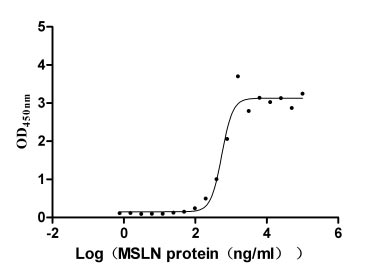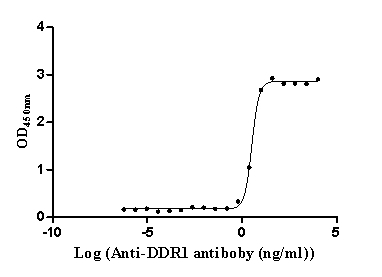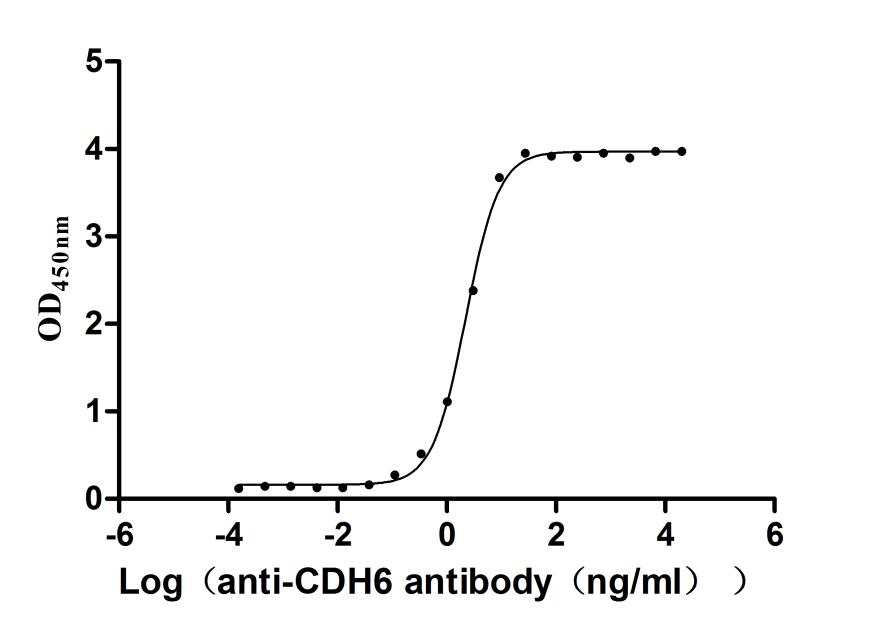Recombinant Mouse 14-3-3 protein beta/alpha (Ywhab)
In Stock-
货号:CSB-YP875120MO
-
规格:¥2208
-
图片:
-
其他:
产品详情
-
纯度:Greater than 90% as determined by SDS-PAGE.
-
基因名:
-
Uniprot No.:
-
别名:Ywhab; 14-3-3 protein beta/alpha; Protein kinase C inhibitor protein 1; KCIP-1) [Cleaved into: 14-3-3 protein beta/alpha; N-terminally processed]
-
种属:Mus musculus (Mouse)
-
蛋白长度:Full Length
-
来源:Yeast
-
分子量:30.1 kDa
-
表达区域:1-246aa
-
氨基酸序列MTMDKSELVQKAKLAEQAERYDDMAAAMKAVTEQGHELSNEERNLLSVAYKNVVGARRSSWRVISSIEQKTERNEKKQQMGKEYREKIEAELQDICNDVLELLDKYLILNATQAESKVFYLKMKGDYFRYLSEVASGENKQTTVSNSQQAYQEAFEISKKEMQPTHPIRLGLALNFSVFYYEILNSPEKACSLAKTAFDEAIAELDTLNEESYKDSTLIMQLLRDNLTLWTSENQGDEGDAGEGEN
Note: The complete sequence including tag sequence, target protein sequence and linker sequence could be provided upon request. -
蛋白标签:N-terminal 6xHis-tagged
-
产品提供形式:Liquid or Lyophilized powder
Note: We will preferentially ship the format that we have in stock, however, if you have any special requirement for the format, please remark your requirement when placing the order, we will prepare according to your demand. -
缓冲液:Tris-based buffer,50% glycerol
-
储存条件:Store at -20°C/-80°C upon receipt, aliquoting is necessary for mutiple use. Avoid repeated freeze-thaw cycles.
-
保质期:The shelf life is related to many factors, storage state, buffer ingredients, storage temperature and the stability of the protein itself.
Generally, the shelf life of liquid form is 6 months at -20°C/-80°C. The shelf life of lyophilized form is 12 months at -20°C/-80°C. -
货期:3-7 business days
-
注意事项:Repeated freezing and thawing is not recommended. Store working aliquots at 4°C for up to one week.
-
Datasheet & COA:Please contact us to get it.
相关产品
靶点详情
-
功能:Adapter protein implicated in the regulation of a large spectrum of both general and specialized signaling pathways. Binds to a large number of partners, usually by recognition of a phosphoserine or phosphothreonine motif. Binding generally results in the modulation of the activity of the binding partner. Negative regulator of osteogenesis. Blocks the nuclear translocation of the phosphorylated form (by AKT1) of SRPK2 and antagonizes its stimulatory effect on cyclin D1 expression resulting in blockage of neuronal apoptosis elicited by SRPK2. Negative regulator of signaling cascades that mediate activation of MAP kinases via AKAP13.
-
基因功能参考文献:
- Data indicate 14-3-3 beta protein as an interacting partner of type 1 cannabinoid receptor (CB1R). PMID: 25002257
- the novel protein interaction mode in the 14-3-3beta.ChREBP alpha2 complex. PMID: 23086940
- Studies suggest that insulin may modulate the cellular function of lipin-1 by regulating its subcellular localization through interactions with 14-3-3 proteins. PMID: 19955570
- 14-3-3 participates in the intracellular trafficking of IRS-1 PMID: 11875115
- The transcription start site was identified and the polyadenylation signals (AATAAA) were found in exon 2 of the mouse gene. In the 5'-upstream sequence, we found three cis elements including a CRE sequence, a TATA box-like sequence, and a C/EBP element. PMID: 12008017
- PRAS40 is a novel substrate of Akt, the phosphorylation of which leads to the binding of this protein to 14-3-3. PMID: 12524439
- 14-3-3beta is a p90 ribosomal S6 kinase (RSK) isoform 1-binding protein that negatively regulates RSK kinase activity PMID: 12618428
- 14-3-3beta gene plays a pivotal role in abnormal growth of tumor cells in vitro and in vivo. PMID: 12896901
- These results indicate for the first time that 14-3-3 protein plays a critical anti-apoptotic role in diabetic myocardium by inhibiting the JNK pathway. PMID: 15240115
- aldosterone increases the expression of 14-3-3beta, which interacts with phospho-Nedd4-2 to block its interaction with ENaC, thus enhancing sodium absorption by increasing apical membrane ENaC density PMID: 16613846
- Cbl-b deficiency. Cbl-b deficiency resulted in increased phosphorylation of T758 in the beta2-chain of LFA-1 and thereby in enhanced association of 14-3-3beta protein with the beta2-chain PMID: 18239087
- Akt1 is necessary for the growth factor stimulated activation of 14-3-3beta-Rac1-p21 activated kinase (Pak) pathway in endothelial cells and fibroblasts. PMID: 18853424
显示更多
收起更多
-
亚细胞定位:Cytoplasm. Melanosome.
-
蛋白家族:14-3-3 family
-
数据库链接:
KEGG: mmu:54401
STRING: 10090.ENSMUSP00000018470
UniGene: Mm.34319
Most popular with customers
-
Recombinant Human Mucin-16 (MUC16), partial (Active)
Express system: Mammalian cell
Species: Homo sapiens (Human)
-
Recombinant Human Prolactin receptor (PRLR), partial (Active)
Express system: Mammalian cell
Species: Homo sapiens (Human)
-
Recombinant Human C5a anaphylatoxin chemotactic receptor 1 (C5AR1)-VLPs (Active)
Express system: Mammalian cell
Species: Homo sapiens (Human)
-
Recombinant Human Epithelial discoidin domain-containing receptor 1 (DDR1), partial (Active)
Express system: Mammalian cell
Species: Homo sapiens (Human)
-
Recombinant Mouse Cell adhesion molecule 1 (Cadm1), partial (Active)
Express system: Mammalian cell
Species: Mus musculus (Mouse)
-
Recombinant Human Carcinoembryonic antigen-related cell adhesion molecule 8(CEACAM8) (Active)
Express system: Mammalian cell
Species: Homo sapiens (Human)
-
Recombinant Human Gastric inhibitory polypeptide receptor(GIPR),partial (Active)
Express system: Mammalian cell
Species: Homo sapiens (Human)
-
Recombinant Macaca fascicularis Cadherin 6(CDH6),partial (Active)
Express system: Mammalian cell
Species: Macaca fascicularis (Crab-eating macaque) (Cynomolgus monkey)





















